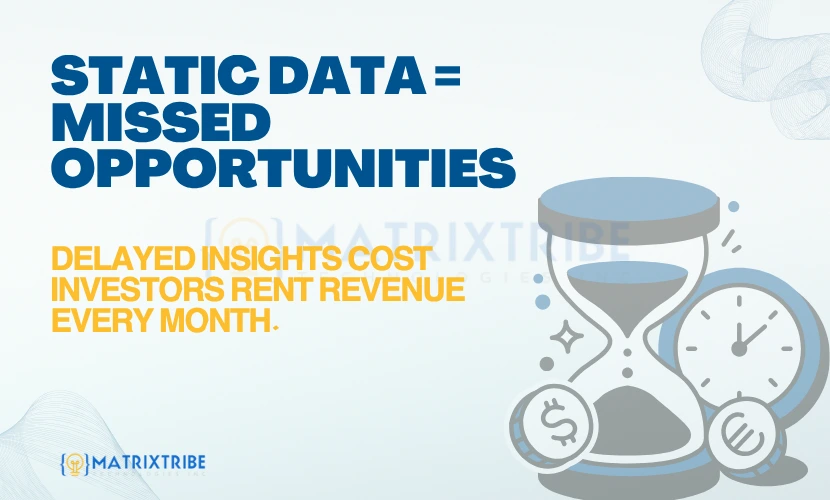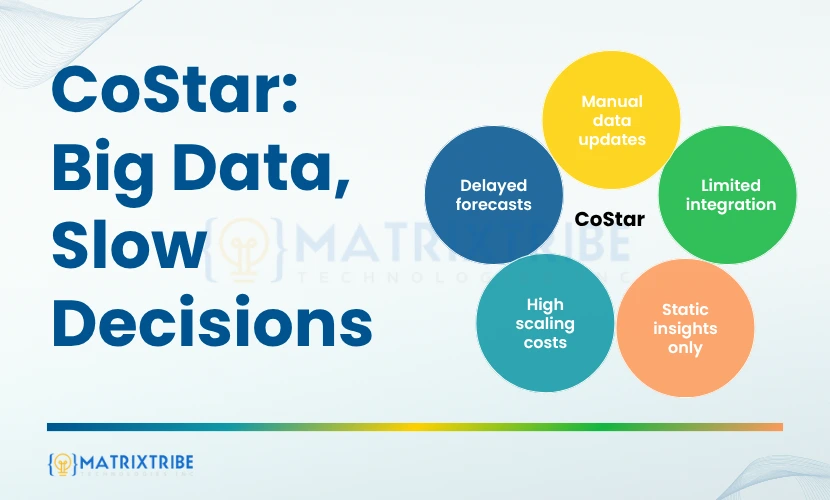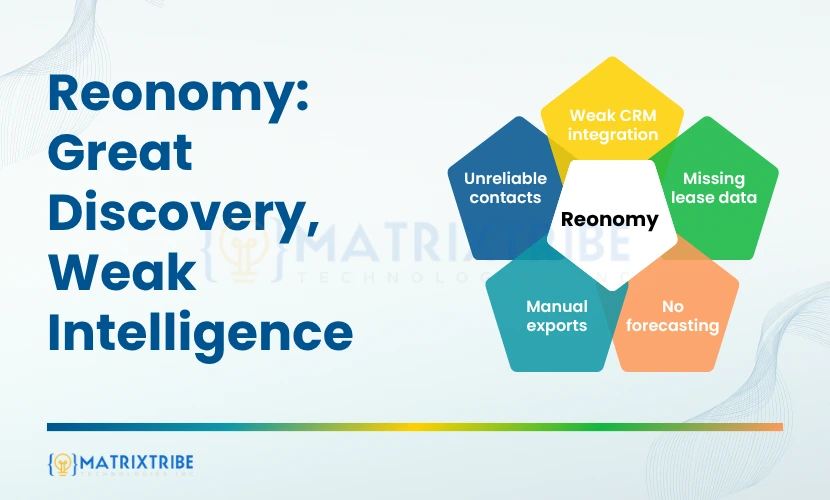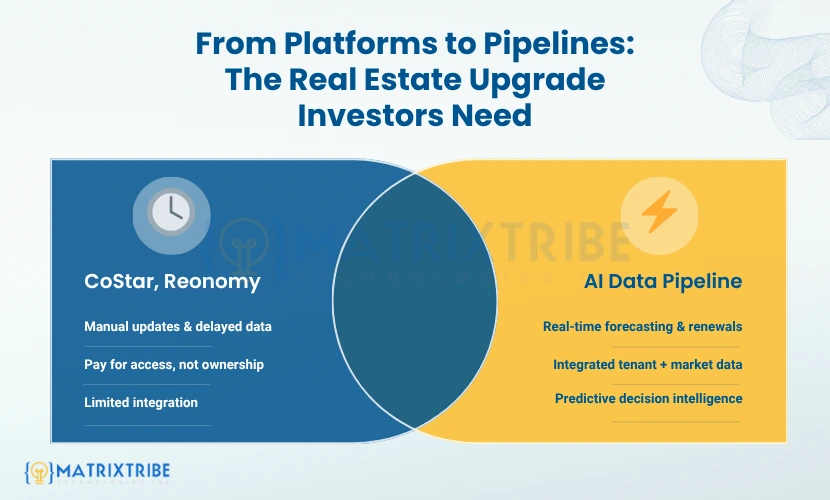

Real Estate
Is It Time to Upgrade from CoStar or Reonomy? A 2025 Guide for Real Estate Investors
October 14, 2025
BLOG
Real Estate Data Intelligence Pipeline: The Competitive Edge Property Managers Need in 2025
Property managers don't need more dashboards; they need intelligence. This article explains how real estate data intelligence pipelines unify existing systems and use AI/ML to deliver decision-ready insights. From rent pricing and churn prediction to forecasting and automated reporting, pipelines enable property management to shift from reactive to proactive. Firms that build them today will be ready for tomorrow's data-driven real estate market.
If you’re a real estate investor still relying on CoStar or Reonomy, you’ve likely noticed the gap between what these platforms show and what you actually need. They provide valuable access to commercial property data, listings, and ownership records. They don’t offer real-time insight into portfolio performance, rental yield forecasting, and income stability.
98% of investors now say upgrading their data systems for AI is a top priority over the next two years. However, the real question is whether to keep renting SaaS platforms or start owning an AI-powered real estate intelligence pipeline.
Let’s explore why the smartest investors are making the shift.
Why Investors Use CoStar and Reonomy
Before we assess their limitations, let's first understand why most investors continue to use them. They deliver a value that is hard to replicate, along with features that seem indispensable. While their core utilities still matter, the landscape is shifting beneath their feet.
CoStar
CoStar is widely regarded as a go-to source for market trends, rental benchmarks, and valuation inputs. It backs its appeal with a massive data investment, as the platform claims to have millions of leases, sales comparables, and records. While the data is impressive, their research method relies on manual data collection to support their analytics.
Reonomy
Reonomoy, on the other hand, is built on property intelligence principles. It combines public and proprietary records into one unified identifier. It helps its users find information about property owners, off-market buildings, and uncover property portfolios.
It simply aids in understanding ownership networks while acquiring new assets. Although it helps you find assets, it doesn't assist in managing or forecasting their performance. Reonomy was built for discovery, not ongoing intelligence.

Where CoStar Falls Short for Investors
Even though CoStar is powerful, it still doesn't cover all the needs of a modern investment portfolio. The following are key limitations to be aware of.
1. Slow performance and UI friction
CoStar's interface can lag and become slow when working with large portfolios or complicated queries. According to G2 reports, "slow performance" is one of the most common complaints regarding CoStar. This latency hinders efficiency when making fast decisions across multiple properties.
2. Limited customization & integration
While CoStar provides standard analytics and benchmarking, it can be difficult to modify the results to your own processes or integrate them with your internal systems. Some users complain that reporting is "inadequate" and difficult to modify. Because property investment is unique and local, off-the-shelf dashboards often overlook critical signals, such as tenant mix quality, occupancy costs, or environmental and maintenance factors that influence long-term asset value.
3. Lack of real-time, unit-level forecasting
CoStar excels at market-level comparisons and lease/sales transactions, but it is not designed to predict rent at the individual unit level in real time.
According to an evaluation of CoStar COMPS, one of the drawbacks is that "data updates are not always in real time, causing access delays." For investors managing multiple income-producing properties, this latency gap can lead to missed rental adjustments, delayed leasing decisions, or unanticipated revenue fluctuations.
4. Cost vs value scaling issues
Many investors end up paying for full CoStar modules or databases that they rarely use. As portfolios develop, the incremental cost of new markets or additional features increases, especially when you're paying for coverage rather than specific value.
Some businesses experience "feature creep" in license charges. However, they discover that they earn more value by developing their own data intelligence layers rather than constantly upgrading SaaS tiers.

Where Reonomy Falls Short for Investors
Reonomy excels in ownership mapping and contact discovery but struggles with operational intelligence and asset performance evaluation. Here are the weak spots of Reonomy for investors wanting real-time action-driven data.
1. Limited Lease Data and Forecasting
Reonomy is largely focused on property features, sales history, debt, and ownership. It does not consistently disclose detailed lease term information, such as individual tenant rents, escalations, or renewal probabilities. According to CRE Daily, their focus is on market and deal discovery rather than lease operations.
In customer reviews, some say that while ownership and contact details are solid, missing or outdated contact information is a common concern. Because lease renewals and tenant decisions are based on nuance (tenant performance, lease structure, local market shifts), the absence of those signals limits what you can build downstream.
2. Limited Operational Metrics
According to user ratings on Capterra, many phone numbers/email addresses in Reonomy's database are reported as "don't work," suggesting that issues with contact reliability may also affect predictive models.
3. Limited Real-time Integration
Although Reonomy offers an API and "data solutions" packages, most reviews highlight limitations in seamless integration with CRMs. In Capterra reviews, several consumers complain about the "lack of integration with our CRM".
For investors managing multiple assets, the lack of real-time data flow necessitates manual aggregation across systems. Hence, it slows down yield forecasting, cash-flow projections, and acquisition due diligence.

The Upgrade Checklist
After seeing where CoStar and Reonomy fall short, the next question is simple: how do you know when it's time to move beyond them? Here's a quick checklist to help you evaluate if your current tools are holding you back.
1. Do I spend hours exporting data just to update reports?
A benchmark report cited property investors reporting inefficiency as a top operational challenge. If your workflow still depends on exporting spreadsheets from CoStar or Reonomy, you're losing valuable time on manual reporting instead of decision-making.
2. Can I see real-time rent comps and renewals at the unit level?
CoStar offers broad comps, but it doesn't deliver unit-level, real-time forecasting. If you can't track renewals and pricing by tenant or by building, you risk losing income. Real-time comps are now critical if you want to move to predictive leasing strategies.
3. Does my data connect to tenant behavior, IoT, and ESG metrics?
Modern portfolios are influenced by tenant satisfaction, building performance, and sustainability targets. Static platforms rarely integrate these signals. For example, Deloitte reports that 59% of real estate firms lack the necessary data and processes to comply with ESG standards.
What an Upgrade Looks Like
Upgrading doesn't mean throwing out tools like CoStar or Reonomy. It means moving beyond their limits by building a system that connects directly to your operations. Instead of static reports, consider a decision intelligence pipeline that transforms raw data into actionable predictive insights.
Decision Intelligence Pipelines Built Around Your Rent Roll
At the core is your rent roll, the single source of truth for income and tenant health. By integrating this with external data (market comps, demographics, occupancy trends), you can shift from reporting what happened to forecasting what will happen.
AI-driven Models for Renewals, Pricing
AI isn't just for market analysis anymore. Predictive models can suggest rental rate adjustments at the unit level. By combining your rent roll with market comps and tenant data, these models deliver real-time rent forecasting that helps maximize occupancy while reducing vacancy losses
Full extensibility: Market Feeds, Smart Building Sensors, Tenant Apps
Pipelines enable you to integrate any data stream, from market feeds for real-time comparisons to IoT sensors for building performance, to tenant engagement apps that measure satisfaction.
Ownership of the Stack
The most important upgrade is ownership. Unlike SaaS platforms that provide access on a rental basis, a custom pipeline is tailored to your portfolio and strategy. You decide where it's hosted, how it scales, and which AI/ML models to run. This means no more paying for generic coverage; your system grows as your assets and needs evolve.

Final Words
CoStar and Reonomy have been extremely useful tools for investors, providing access to commercial property data, listings, and ownership information. However, as portfolios become more complicated, these platforms can no longer meet the demand for real-time rent forecasting, rental rate optimization, and predictive decision-making. Real estate investors who continue to rely on static platforms risk falling behind in an industry where AI and data intelligence pipelines are rapidly becoming the norm.
The upgrade path is straightforward: complement broad market data with a pipeline tailored to your rental data. This is how you can transition from reactive to predictive operations, and from generic software to intelligent solutions that produce genuine outcomes.
Upgrade From Platforms to Pipelines
If you're an investor ready to stop working around static CRE platforms, it's time to own your decision intelligence. At MatrixTribe Technologies, we design and engineer AI/ML-powered real estate data intelligence pipelines that seamlessly integrate into your existing workflows. From rent forecasting to rent optimization, we help you cut vacancy, optimize renewals, and future-proof your portfolio.
Contact MatrixTribe today and discover how your data can start working for you.

Latest Article




